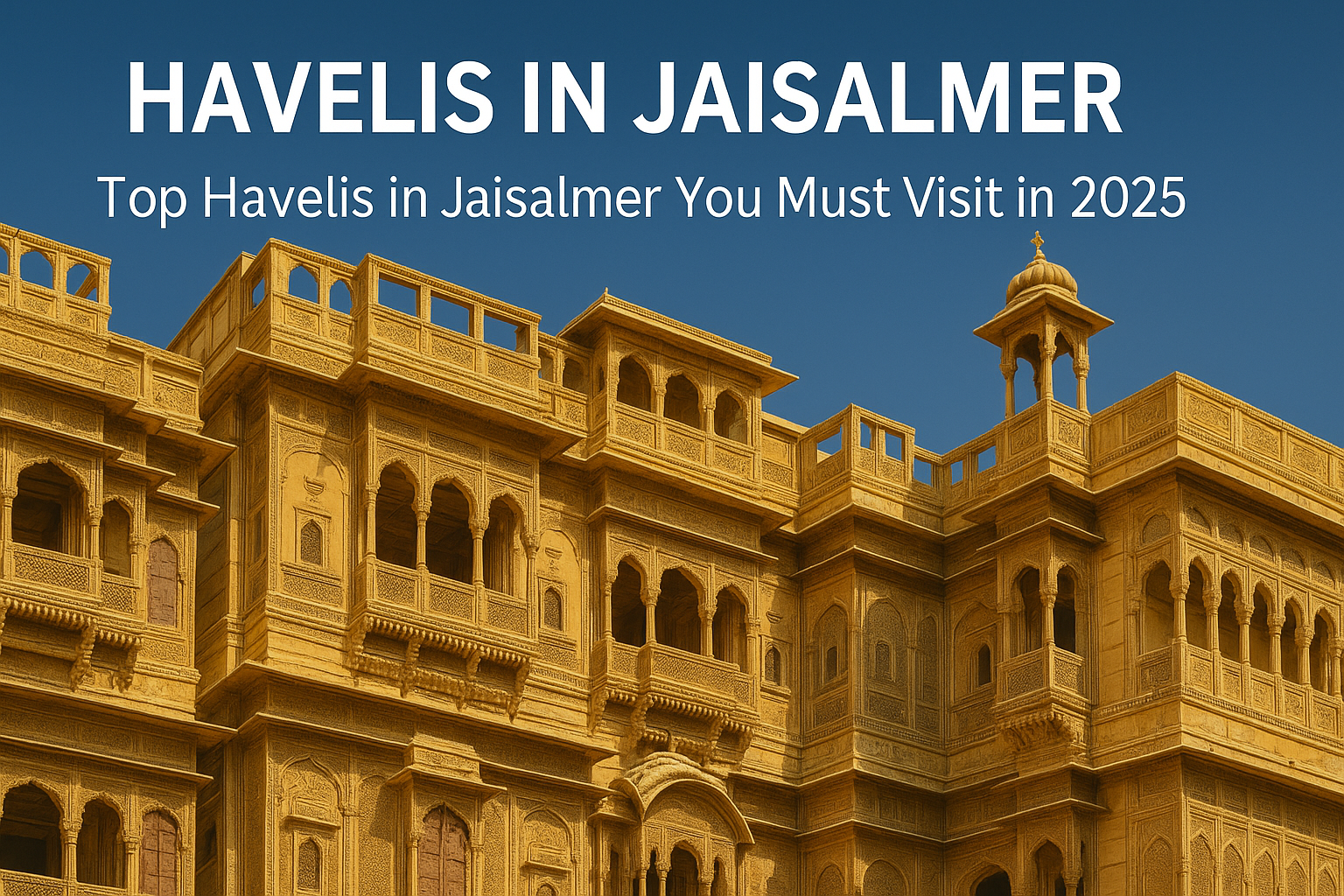Table of Contents

havelis in jaisalmer
When people think of Jaisalmer the first things that come to mind are desert safaris, luxury camps, Jeep Safari and camel rides. But Jaisalmer is not just about sand dunes and adventure. It is also well known for its beautiful and historic havelis. These havelis were once the homes of wealthy merchants and royal families. Today, they are famous for their detailed carvings, golden sandstone architecture, and rich cultural history. Tourists from all over the world come to see these amazing mansions that reflect the glory of Rajasthan’s past.
In this blog, we’ll explore some of the most famous havelis in Jaisalmer and discover what makes them so special.
What is a Haveli?
A Haveli is a traditional Indian mansion, typically built by merchants or nobles, featuring:
- Intricate carvings
- Courtyards and jharokhas (overhanging balconies)
- Detailed frescoes and artwork
- Privacy walls (for purdah system)
These were not just homes but statements of power, art, and culture. In Jaisalmer, havelis served both residential and commercial purposes and reflected the prosperity of the city, which sat on the ancient Silk Route.
Why Are Jaisalmer’s Havelis So Special?
Jaisalmer’s havelis are globally recognized for:
- Unique yellow sandstone architecture
- Delicate latticework and stone carvings
- Blending of Rajput and Islamic design
- Historical stories of merchant families
- Tourist accessibility and preservation
Most of these havelis are centuries old, yet they stand strong against time, wind, and sand.
Discover Why Jaisalmer is Called the “Golden City” of Rajasthan.
Famous Havelis of Jaisalmer You Must Explore
1. Patwon Ki Haveli
- Built by: Guman Chand Patwa, a wealthy trader
- Year: Early 1800s
- Unique Fact: It’s not one but a cluster of five havelis, making it the largest in Jaisalmer.
Patwon Ki Haveli is the most famous and most visited haveli in Jaisalmer. It is known for its exquisite carvings, mirrored ceilings, miniature paintings, and a variety of rooms and corridors. The haveli reflects the grandeur of the Patwa family, who were one of the richest merchants in their time.This is also a unique photo places in Jaisalmer .Today, a part of this haveli has been converted into a museum that displays textiles, antique furniture, coins, and artifacts from centuries ago.
2. Salim Singh Ki Haveli
- Built by: Salim Singh, Prime Minister of Jaisalmer in the 19th century
- Unique Feature: Peacock-shaped roof and narrow entrance
- Known for: 38 intricately carved balconies, each with a different design
This haveli stands out for its distinctive architecture. The upper floors curve like a ship’s stern, earning it the nickname “Jahaz Mahal” (Ship Palace). It gives a peek into the luxurious lifestyle of Jaisalmer’s powerful ministers.
The legend says Salim Singh wanted his haveli to be taller than the Jaisalmer Fort. The Maharaja did not approve and ordered the top floors to be dismantled.
3. Nathmal Ki Haveli
- Built by: Two architect brothers – Hathi and Lulu
- Style: Blend of Rajput and Islamic architecture
- Famous for: Elephants carved at the entrance and modern touches like fans and cars
What makes Nathmal Ki Haveli interesting is that the two brothers worked simultaneously but separately, and as a result, both sides of the haveli are slightly different yet symmetrical.
Inside, visitors can see paintings made using real gold and fine miniature artwork. The haveli is still partially inhabited.
4. Tazia Tower
- Location: Inside the Badal Palace complex
- Purpose: Replica of Tazia (religious Islamic structure)
- Built by: Muslim craftsmen for royal family
Although not a traditional haveli, the Tazia Tower is an artistic marvel and reflects the cultural harmony of Jaisalmer. Each floor of the tower has its own unique design.
If You Planning Jaisalmer Trip Must Read this blog :- Travel Guide for Jaisalmer
The Art and Craftsmanship of Jaisalmer Havelis
The highlight of Jaisalmer havelis is the stone carving that looks almost like wood. Without any machines or modern tools, artisans of that era achieved a level of detail that even modern architects admire.
From jharokhas (overhanging balconies) to chhatris (domed pavilions) and jali (lattice work), every part of these havelis speaks of perfection. No two balconies or windows look the same — that’s how custom and detailed the designs are.
Inside, you’ll often find:
- Courtyards surrounded by rooms
- Pillars with floral and geometric designs
- Hand-painted frescoes and wall art
- Mirror work and stained-glass windows
The Role of Havelis in Jaisalmer’s Tourism
Tourism is the lifeline of Jaisalmer, and havelis play a key role in attracting visitors from India and abroad. Here’s how:
1. Cultural Heritage
Havelis help tourists understand the lifestyle, wealth, and values of ancient Marwari merchant families.
2. Architecture Enthusiasts
Architecture students and history buffs visit these havelis to study design, art, and urban planning of medieval India.
3. Photography and Film
The beautiful sandstone work makes them perfect spots for photo shoots, films, and travel documentaries.
4. Museum Experience
Some havelis like Patwon Ki Haveli have been converted into museums, offering guided tours, heritage displays, and cultural stories.
5. Boosting the Local Economy
Entry tickets, guided tours, souvenir shops, and cafes around these havelis generate employment and support the local economy.
Tips for Visiting Jaisalmer’s Havelis
- Best Time to Visit: October to February (cool and pleasant weather)
- Timings: Usually open from 9 AM to 5 PM
- Entry Fee: ₹20–₹100 depending on the haveli
- What to Carry: Camera, water bottle, and comfortable walking shoes
- Guided Tour: Highly recommended for detailed historical insights
Conclusion
The havelis of Jaisalmer are not just buildings; they are time machines. They take you back to an era of silk traders, caravan routes, royal feasts, and desert grandeur. In a world moving fast towards glass skyscrapers and modernity, these havelis remind us of a time when craftsmanship, culture, and community were at the heart of every home.
Whether you’re a tourist, history lover, or an art enthusiast, walking through these havelis is like reading a living book made of stone.
So next time you plan a trip to Rajasthan, don’t miss the golden glory of Jaisalmer’s havelis — where every wall whispers a royal secret.
